EDB analysts weigh pros of Uzbekistan’s accession into EAEU
EDB analysts weigh pros of Uzbekistan’s accession into EAEU

Analysts of the Eurasian Development Bank (EDB) have assessed the consequences of Uzbekistan's possible accession to the Eurasian Economic Union (EAEU). According to their forecast, this would allow Tashkent to significantly increase the inflow of infrastructure investments and money transfers, expand exports, and strengthen industrial cooperation. The EAEU itself would also benefit from the expansion. They call Uzbekistan one of the key elements of the" puzzle " of economic integration in Central Asia. Official Tashkent, however, is not in a hurry to make fateful decisions yet.
EDB analysts have released a report on the prospects and potential effects of Uzbekistan's economic integration into the EAEU (which includes Armenia, Belarus, Kazakhstan and Kyrgyzstan in addition to Russia). According to them, the country's accession to the EAEU would give it a number of advantages. First, the annual potential volume of infrastructure investments from the EAEU to Uzbekistan might reach $1-1. 5bn. This would provide an additional 0.3-0.4 percentage points of growth in the real GDP of per annum.
Analysts note that Uzbekistan is attractive from the point of view of expanding business and directing foreign direct investment from the existing member states of the union since the republic has significant natural and labor resources, as well as an industrial base. Raising investments would contribute to increasing labor productivity in Uzbekistan both through the renewal of physical infrastructure and through the introduction of new technologies.
Secondly, access to the common labor market of the EAEU would on average give an additional inflow of remittances to Uzbekistan in the amount of $1.5–2bn per year, and an additional contribution to the annual growth of real GDP would be 0.3–0.4 percentage points. Experts forecast that labor migration to the EAEU member states would help mitigate the negative socio-economic consequences in Uzbekistan caused by unemployment.
Third, experts predict that the expansion of intra-industry trade and industrial cooperation between Uzbekistan and the current EAEU member states would contribute to the diversification of the structure of the economy and the country's export basket. According to the results of 2020, the republic's exports to the EAEU member states amounted to $3bn. Analysts suggest that if Uzbekistan joins the union, this figure could grow significantly.
Taking into account all factors, the growth rate of Uzbekistan's potential GDP after joining the EAEU might increase to 6.9-7.2% per year from the current 5.5%.
The report notes that Uzbekistan lags behind the majority of the EAEU member states in terms of per capita income. The GDP of the republic per capita at purchasing power parity amounted to $7,400 in 2020. According to this indicator, Uzbekistan surpasses Kyrgyzstan, but it is more than 3.5 times behind Russia and Kazakhstan, more than 2.5 times behind Belarus and almost twice behind Armenia. One of the reasons for the lag in income levels is the low productivity of economic sectors: in agriculture (it forms 25% of GDP), this indicator is twice lower than in Russia and Belarus, in industry and construction-four times lower than in Kazakhstan. In the systemic plan, the lack of investment, technology, as well as the current state of the physical infrastructure prevents the increase in economic productivity.
Nevertheless, EDB experts name Uzbekistan, located "at the crossroads" of Eurasia, one of the key elements of the" puzzle " of economic integration in Central Asia. "Without the participation of Uzbekistan as a major and strategically located player in the Central Asian space, it is difficult to solve the issues of the region's development," the report concludes.





.png)



















